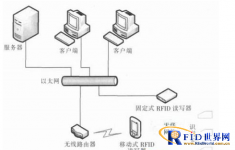
Personnel rescue system solution based on Internet of Things technology
[ad_1]
Overview
Although the world is highly advanced in science and technology, “natural disasters” such as sudden natural disasters and public health incidents, and “man-made disasters” such as mistakes in decision-making, terrorism, and regional military conflicts still occur from time to time. The “911” terrorist attacks abroad, flooding in New Orleans, the Wenchuan earthquake in China, and frequent mining disasters and accidents. The problems exposed by these emergencies remind us that the efficiency of the emergency communication system must be improved as soon as possible. RFID is a technology that can effectively improve the effectiveness of emergency communication systems.
system structure
The RFID identification card made on the basis of radio frequency identification technology can meet the requirements of small size, light weight, easy to carry, strong and wear-resistant, strong anti-destructive ability, and is suitable for people to carry. In order to prevent it from falling off or losing, it can be fixed on the clothes or sewn into the clothes interlayer, the carrying (matching) belt position is taken on the left chest, or it can be used as a functional module to be embedded in other carry-on equipment. As shown in the figure below, the wounded treatment system consists of 5 parts, including server, client, mobile RFID reader, fixed RFID reader and individual RFID identification card. The system adopts B/S mode.

Schematic diagram
1) Server: The server is responsible for data storage and sharing, and is connected to the client through the network, and data is shared between the clients; it is connected to the front-end mobile RFID reader through the wireless network, and can receive the data collected by the front-end.
(2) Client: The client is connected to the server to obtain the required data through the Ethernet, and provides functions such as man-machine operation interface, data processing, storage, statistical analysis, query, and system management.
(3) Mobile RFID reader: composed of PDA and RFID reader with CF interface, as a front-end data collection device, responsible for data collection, storage, communication, transmission, query, data processing, man-machine interface, etc. Features.
(4) Fixed RFID reader: As the RFID data reading and writing device of the ambulance, it is connected to the client and is responsible for the identification of the wounded, data collection, data storage, communication, transmission and other functions.
(5) RFID identification card (tag, tag): RFID active tag is used as the original data source, carrying relevant information about the wounded, storing electronic medical records, etc., and it can also use a wristband.
(6) The server and the client are interconnected through the network.
(7) The mobile RFID reader and the background software (server+client) are connected via a wireless network.
work process
After the paramedics arrived at the scene for the first time, they completed the emergency rescue. They distributed the RFID identification card to the wounded and filled in the electronic injury information. The injury information was written into the RFID identification card and stored by the mobile RFID reader, and then stored in the network. Under the conditions, the injury information will be transmitted to the treatment organization (if there is no network, the data will be temporarily stored first, and the data will be transmitted later after the network is restored) for a unified analysis of the data.
(1) Classification: Read the information in the RFID identification card of the wounded through a mobile RFID reader, and diagnose the wounded. After diagnosis, classify, fill in classification information on the mobile RFID reader or fixed RFID reader (that is, whereabouts of treatment, including location, medical institution, etc.), and write the classification information, classification time, etc. into the wounded RFID identification Card, the background system will update accordingly, and send the classification information to each medical institution.
(2) After classification, the wounded were sent to various medical institutions on a stretcher. The medical institution reads the wounded information stored in the wounded RFID identification card, and the doctor will deal with the wounded accordingly; at the same time, complete the wounded medical record based on the wounded information and the actual inspection results and relevant regulations, and write the medical record into the RFID Recognize the card and update the background system accordingly.
(3) The follow-up diagnosis and treatment information of the wounded in the medical institution also needs to be written into the RFID identification card, and then the background is updated accordingly.
(4) After the wounded is treated in a medical institution, they may be transferred to other medical institutions. The work process of other medical institutions is the same as above.
(5) Comprehensive utilization of information outside the process, including: statistical analysis function, combined query function, automatic classification, intelligent diagnosis, automatic rationing of equipment and drugs, logistics, etc.
[ad_2]


